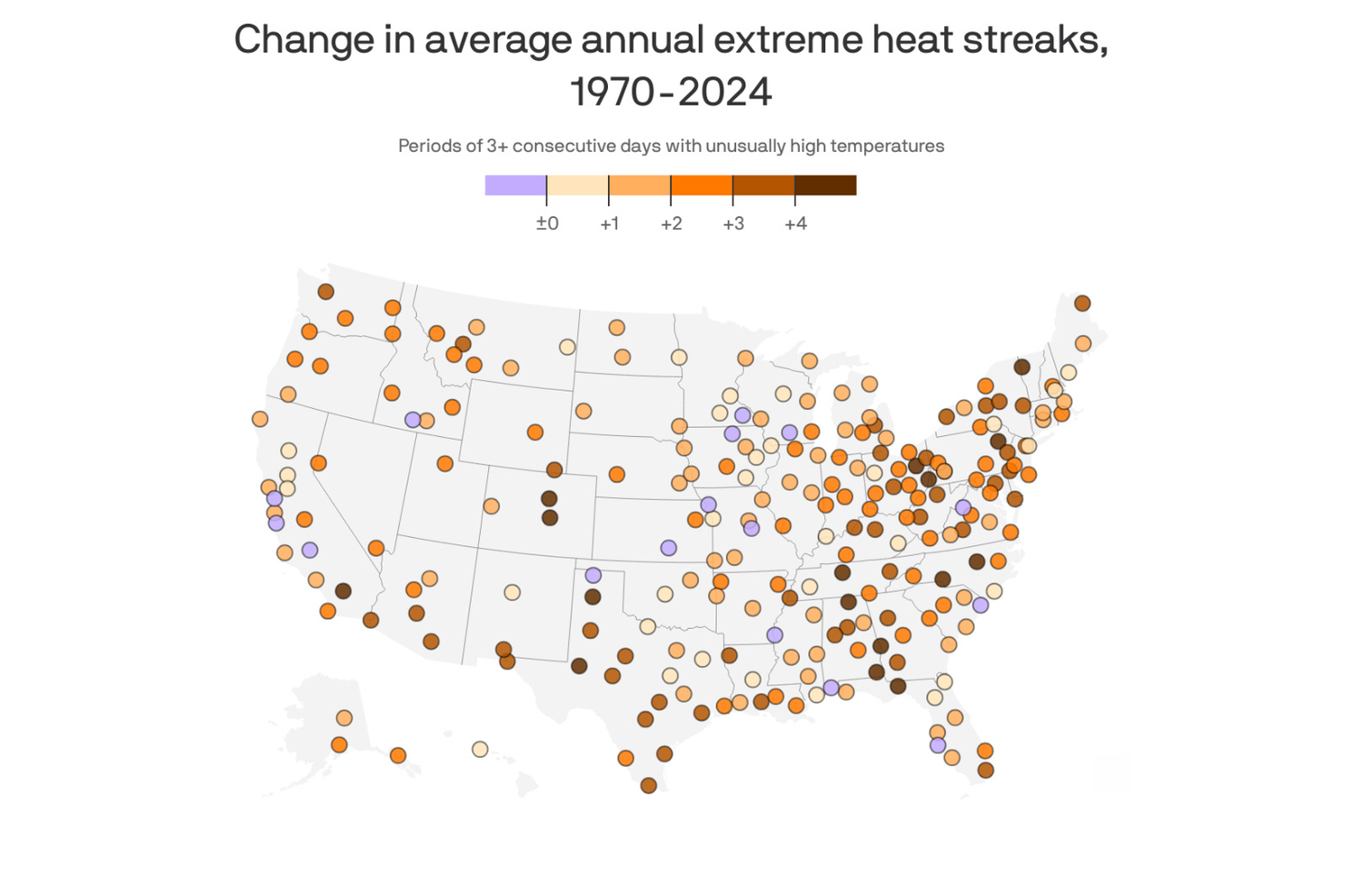
Twice a month, we’re compiling the most relevant news stories from diverse sources online, connecting the latest environmental and energy economics research to global current events, real-time public discourse, and policy decisions. Keep reading, and feel free to send us your feedback.
Here are some questions we’re asking and addressing with our research chops this week:
The US Environmental Protection Agency proposes a repeal of the “endangerment finding”—what could this repeal cost society?
The US Environmental Protection Agency (EPA) released a proposal last week that would rescind the “endangerment finding,” the agency’s 2009 declaration that greenhouse gases endanger human health and welfare. The finding has served as the legal basis for EPA regulations that limit greenhouse gas emissions, and its repeal could mean that many of these regulations are at risk of being eliminated. In a new In Focus video, Resources for the Future (RFF) President and CEO Billy Pizer breaks down the endangerment finding and outlines the potential economic and societal costs of its repeal. Pizer also highlights the continued importance of research on these costs and the economic benefits of policies that aim to reduce emissions. “There’s still a lot of work to do on climate change, regardless of what happens with the endangerment finding development,” says Pizer.
What are the economic and environmental implications of public land policy changes?
This year, the federal government authorized significant changes to the management of public lands, including cuts to National Parks Service staff and rescinding protections for undeveloped forests. Meanwhile, Congress considered and later removed a provision in the recent reconciliation bill to sell millions of acres of public lands to address housing affordability challenges. In RFF’s second If/Then webinar last week, RFF Senior Fellows Margaret Walls and David Wear and Fellow Brian C. Prest discussed the breakneck speed of policy changes and insights about what’s on the horizon for public lands based on recent If/Then analyses. Panelists discussed the potential for federal land sales to increase affordable housing, the impact of reduced royalty rates on federally leased oil and gas drilling, and the feasibility of timber harvesting to reduce wildfire risk. Panelists emphasized the importance of prudent public land management for natural resource revenues, wildfire risk reduction, and communities that rely on the economic boost from visitors to public lands. Watch the recording of the event here.
How will a policy environment that rolls back regulations on natural gas and coal impact energy prices in the United States?
The California State Legislature recently announced a proposal to relax fossil fuel emissions standards in response to rising energy costs, particularly gasoline. This proposal comes as lawmakers debate the policies that can address rising energy costs as increased demand places strain on US capacity. While the Trump administration has argued that increased coal and natural gas deployment is key to achieving energy affordability, modeling shows that phasing out tax credits for renewable energy in favor of fossil fuels may increase annual electricity bills for Americans. In a new blog post, RFF Senior Research Associate McKenna Peplinski and Research Associate Nicholas Roy compare projected electricity prices under scenarios that incentivize investment in renewable technologies and scenarios that loosen regulations on natural gas and coal plants. “Altogether, these analyses suggest that a policy approach that emphasizes fossil fuel build-out increases retail electricity rates and the uncertainty of electricity costs, relative to a grid with expanded renewable generation,” say Peplinski and Roy.

Resources Roundup

Financial Institutions Are Important for the Success of the Energy Transition
On the Resources Radio podcast, Heather Zichal discusses her career in climate policy and highlights the important role of financial institutions in advancing the energy transition. Zichal—who has developed climate policy from positions in the US Congress, the executive branch, and nonprofits—now serves as the global head of sustainability at JPMorganChase. She explains how financial institutions support decarbonization through green finance commitments, facilitating the sustainability goals of their clients, and investing in emerging technologies. Zichal underscores the importance of promoting climate solutions that balance environmental and business priorities. One additional note: the Resources Radio team is taking a summer break for the month of August. If you need some brain candy to tide you over in the meantime, the podcast hosts have you covered. They’ve shared some of their favorite episodes of the podcast along with recommendations for books and other podcasts. We’ll be in your podcast feed again come September!
How Have Environmental Review Processes Impacted Renewable Energy Projects?
The National Environmental Policy Act (NEPA) of 1969 established a mandatory process of environmental review for major projects funded by federal agencies, including highway construction, oil and gas drilling, and solar and wind energy development. NEPA often is identified as a major obstacle to renewable energy projects when the review process itself creates delays or approval of the project is challenged in court. In two related reports, RFF Visiting Fellow Arthur G. Fraas, Research Associate Emily Joiner, and collaborators examine whether environmental court challenges or the NEPA process significantly delay renewable energy projects. The authors show that court challenges delay the operational status of wind and solar projects, but renewable projects complete the NEPA process in less time, on average, than other federal projects.
Repeal of Power Plant Pollution Standards Fails Benefit-Cost Analysis
In June this year, the US Environmental Protection Agency (EPA) proposed a repeal of existing carbon pollution standards for fossil fuel power plants. EPA argued that the repeal would reduce energy costs and help meet rising electricity demand by allowing power plants to increase their output. However, the repeal likely will increase greenhouse gas emissions and may impose other hidden costs in the United States and abroad. In a new issue brief, RFF Senior Fellow Karen Palmer and Research Associate Nicholas Roy analyze the economic costs of increased greenhouse gas emissions and complete a cost-benefit analysis to evaluate the impact of the repeal on climate change, household energy costs, and healthcare costs. If EPA conducted a cost-benefit analysis with up-to-date projections and tax credits, then “the repeal of carbon pollution standards would fail traditional cost-benefit tests even without consideration of greenhouse gas emissions,” say Palmer and Roy.

Improved Satellite Data Can Forecast Floods Sooner
As severe weather events increase due to climate change, floods pose a major threat to communities. Accurate and early flood forecasts can save money and lives by giving emergency services enough time to implement pre-flood mitigation strategies and evacuation plans. In a new journal article, RFF Nonresident Fellow Richard Bernknopf, Fellow Yusuke Kuwayama, Research and Policy Engagement Associate Samiha Shahreen, and collaborators quantify the economic value of improved flood forecasts. Their recent journal article is a product of the VALUABLES Consortium, a six-year research collaboration between RFF and NASA that ended in December 2023. The authors show that data from satellites can increase the timeliness of flood hazard planning, as in one particular case in North Dakota, where improved forecasting could have reduced the damages incurred by $1.7 million.

#ChartOfTheWeek

Credit: Climate Central, Alex Fitzpatrick / Axios Generate
This summer brought climate change–driven heat waves all across the United States. Heat waves in June broke daily heat records in more than 50 northeastern US cities, and the average temperature that month was 2.8°F above the twentieth-century average. This map illustrates how trends in extreme heat have shifted in the United States from 1970 to 2024. It shows the change in average annual “heat streaks”—periods of three or more days in a row with unusually high temperatures—and reveals that many cities have more heat streaks on average every year.








